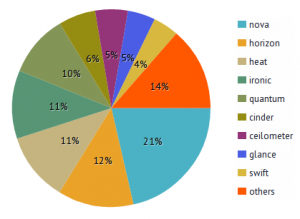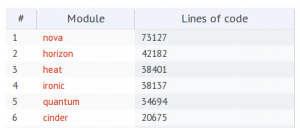Hong Kong Summit – Registration, Call for Speakers & Sponsors Now Open!
在全体大会中将提供英文至中文之即时翻译。 要得到更多信息, 请查阅注册信息页
OpenStack Summit Survey Results
Key Findings:
- Overall: 96% of people rating the overall Summit as Good or Excellent.
- Top areas to improve: Clearly the Network and the Session Rooms (size, acoustics, equipment) were unacceptable.
- Format: Stackers favored keeping the Design Summit co-located with the rest of the Summit sessions by a margin of 4:1 over breaking it out separately
Up for a challenge? Here’s the OpenStack Essentials quiz!
Novice, hotshot, expert or wizard? Show off your OpenStack knowledge in this brand new quiz by Florian Haas Hastexo team. The OpenStack Essentials quiz is a challenging, fun way for you to test your OpenStack knowledge. It takes no more than 30 minutes, or maybe even just 10 if you’re super awesome.
Python APIs: The best-kept secret of OpenStack
As an OpenStack user or administrator, you often need to write scripts to automate common tasks. In addition to the REST and command-line interfaces, OpenStack exposes native Python API bindings. Learn how to use these Python bindings to greatly simplify the process of writing OpenStack automation scripts. An article on DeveloperWorks by Lorin Hochstein, Lead Architect, Cloud Services, Nimbis Services
A puppet module for building Windows/Hyper-V OpenStack Compute nodes
Peter Pouliot has been working on a A starting point for building Windows/Hyper-V OpenStack Compute nodes. The modules he recently pushed begin the configuration of a openstack-hyper-v compute node for openstack. It currently has the beginings of both from package and from source options. This is still a work in progress, contributions are welcome.
Tips ‘n Tricks
- By XLcloud: Devstack with GRE tunnels in Havana
- By eNovance: Using Duplicity with Cloudwatt for online backups
- By Ryan Lane: Per-project users and groups (aka service groups)
- By Mate Lakat: OpenStack – XenServer – type Image to Volume
- By Logilab: About salt-ami-cloud-builder
- By Giulio Fidente: OpenStack Glance – Use Swift as backend
Upcoming Events
- EuroPython 2013 Jul 01 – 07, 2013 – Firenze, Italy Details
- FISL 14 Jul 03 – 06, 2013 – Details
- PyCon Australia – OpenStack Miniconf Jul 05, 2013 – Hobart, Australia Details
- Deploying a 3D Virtual World on OpenStack Cloud Jul 05, 2013 – Hong Kong Details
- Austin Meetup Jul 11, 2013 – Austin Details
- Boston Meetup Jul 16, 2013 – Boston Details
- OSCON 2013 Jul 22 – 26, 2013 – Portland, OR Details
Reports from Previous Events
- Report: June month OpenStack meetup, Bangalore , India
- Notes suite au 4ème rendez-vous OpenStack à Paris
- OpenStack Italia User Group Meetup, Milan, June 20
Other News
- What’s Up Doc? Jun 21, 2013
- Interview with Hui Cheng at UnitedStack
- Interview with Joe Arnold, founder and CEO of Swiftstack
- What I think about CephFS in OpenStack
- OpenStack Project Meeting: Summary and full logs
- OpenStack Community Meeting: Summary and full logs
- OpenStack Board Meeting Summary – June 27th
Welcome New Developers
- Scott Dangelo, HP
- Kai Zhang, Zelin.io
- Sai Krishna
- Anastasia Latynskaya, Mirantis
- Mahesh Panchaksharaiah, Thoughtworks
- Sridevi Koushik, Rackspace
- Jacob Cherkas, Nicira
Got answers?
Ask OpenStack is the go-to destination for OpenStack users. Interesting questions waiting for answers:
- how to configure IPv6 for openstack
- Instances running on VMware ESXi cannot access metadata service
- ceilometer coercing to Unicode: need string or buffer, NoneType Found
- route fixed ip to floating ip
- How to query Billingstack after you installed it?
- Devstack exercise script failures
- What causes instance names to increment by 3?
- how to configure IPv6 for openstack
- Snapshot file is created on disk, but never shows up as a snapshot
- Why is this ovs-vsctl running so often
- Configuring dm-crypt inside host?
- Healthnmon NoSectionError error
- Not able to set cpuset attribute.
- Swift/Keystone authentication failure
- how services token buffer work
- How to install healthnmon in Ubuntu?
Love animated GIFs?

When I run Tempest.
The weekly newsletter is a way for the community to learn about all the various activities occurring on a weekly basis. If you would like to add content to a weekly update or have an idea about this newsletter, please leave a comment.



















